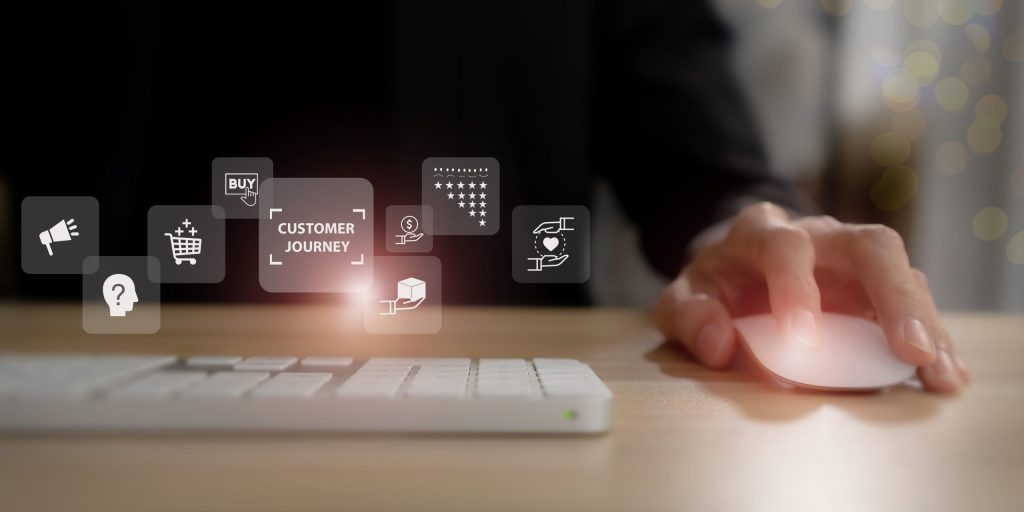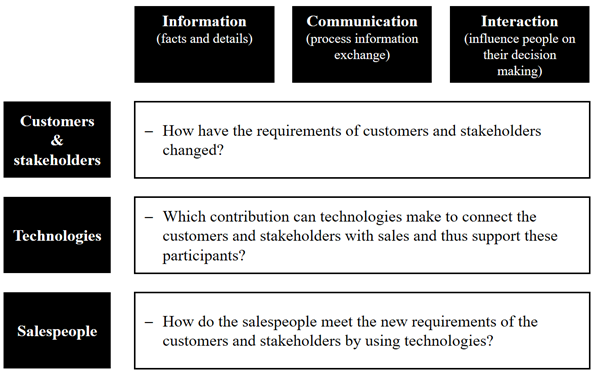Vierailin syyskuussa Satu Kivelän Havaintoja muutoksesta ja merkitysten etsijät -ohjelmassa YLE Radio1:ssä keskustelemassa naisyrittäjyydestä. Ohjelma rakentui teorian ja käytännön vuoropuhelulle:…
Tekijät | Authors

Digital Transformation of B2B Sales: Changes in customer relationships
Sales is the interface between the customer and the supplier company. Sales is responsible for analyzing customer needs, deriving suitable value propositions, the actual selling of products, and the strategic alignment of sales activities. The shift from traditional relationships to digital relationships is enabled via touchpoints along the customer journey.
Traditionally sales has differentiated between business-to-business (B2B) sales and business-to-consumer (B2C) sales. While in B2B sales, private companies are target customers, in B2C sales, consumers are targeted (Hutt & Speh, 2017; Lilien, 2016). However, this clear differentiation becomes less and less relevant, and the lines between both domains are constantly blurring. The application of digital technologies, the ubiquity of information and changing customer demands make sales more complex. This is causing a shift of B2C characteristics to the B2B domain (Gummesson, 2002; Mingione & Leoni, 2020). As the coronavirus pandemic led to an acceleration of digitalization of the B2B domain, making the customer relationships in B2B sales is profoundly changing (Giovannetti et al., 2023; Rangarajan et al., 2021). The shift from traditional relationships to digital relationships is recognizable, and the design of hybrid relationships is crucial to succeeding in today’s B2B market (Ramos et al., 2023; Thaichon et al., 2018).
Evolutionary stages of customer relationships
Today’s digital or hybrid relationships are the result of a long evolution. In the 1950s, the relationships were considered very simple: sales-focused and transaction-oriented. The customer was seeking a new product, and sales was seeking new customers. Both parties agree on buying/selling conditions by exchanging information. After this, the customer buys the product, and in return the product is delivered (Shaw et al., 2007; Webster, 1965).
Later, marketers recognize that the purchase decision of customers is influenced by the situation. For this reason, it depends on a certain industry, product, technology, or purchasing stage whether a customer wants to buy or not, making the customer relationship as more dynamic (Prahalad & Ramaswamy, 2000). In the 1970s psychological and behavioral variables were also considered to describe and influence buying decisions (Chavan et al., 2019; Sheth, 1973). This resulted in a response-based approach to customer relationship management, where both customer’s internal perspective and sellers influencing activities through marketing have an impact (Choffray & Lilien, 1978; Steward et al., 2019).
From the 1980s onwards, a change from short-term relationships to long-term relationships with customers were seen as the basis for competitive advantage. At the same time, it was recognized that the relationship between customers and suppliers is not only two-sided relationship, but a complex network (Gummesson, 2002).
From customer relationships to the customer journey
The changing customer demands and the increasing influence of digital technologies result in the most recent view at relationships: the customer journey. Customer journey is a goal-oriented path to describe purchasing and offerings along multiple touchpoints. Customer journey steps are steps that a customer goes through when moving along the customer journey and touchpoints are interaction points between supplier and customer (Purmonen et al., 2023).
Customer journey has three steps. The pre-purchase step considers all relevant interactions of the customer before buying. The customer considers certain brands, collects relevant information and tries to find out who can satisfy his needs. The second step – purchase – describes all interactions of the customer with the seller and the environment during the purchase. This includes making the choice, ordering the product and payment. Within the post-purchase step, the customer interacts in certain ways with the seller and the environment. (Lemon & Verhoef, 2016).
Customer journey has pre-purchase, purchase and post-purchase steps
Companies try to automate the sales and purchasing processes, designing a seamless customer experience along the whole journey and providing suitable touchpoints for the customer (Edelman & Singer, 2015; Lemon & Verhoef, 2016; Steward et al., 2019). Touchpoint can support customers regarding collection of relevant information, enable contact to human salespeople or allow payments or usage. As touchpoints serve different needs, they should be treated differently to satisfy customer needs (Lundin & Kindström, 2023).
Aligning sales activities
Digital technologies offer new opportunities to establish and maintain customer relationships and can be applied along the customer journey for a variety of purposes (Agnihotri et al., 2023; Voss et al., 2023). Fischer et al. (2023) describe that the digital transformation of sales leads to a profound change in the customer-sales relationship and therefore triggers a fundamental change in the sales function. Their framework postulates that companies must rethink the information they provide their customers, as well as how they communicate and interact with them. To design customer-sales relationships that meet the requirements of the described changes above, companies must align their sales activities with the customer demands and think of how they can meaningfully integrate digital technologies to beneficially connect customers, stakeholders, and salespeople (Figure 1). To do so, companies must ensure the readiness of their salespeople towards those new relationships and changes of sales practices (Fischer & Seidenstricker, 2024; Giovannetti et al., 2022).

Figure 1. Design of digital customer-sales relationships.
Further reading
Fischer, H., Berger, T., & Seidenstricker, S. (2023). Digitizing the sales process of SMEs: Development tendencies and relevant technologies. In E. Akcaoglu & R. Wehner (Eds.), Managing the Challenges of Today’s Economic Landscape (pp. 9–26). Würzburg International Business Press
References
Agnihotri, R., Chaker, N. N., Dugan, R., Galvan, J. M., & Nowlin, E. (2023). Sales technology research: A review and future research agenda. Journal of Personal Selling & Sales Management, 43(4), 307–335.
Chavan, G. D., Chaudhuri, R., & Johnston, W. J. (2019). Industrial-buying research 1965-2015: Review and analysis. Journal of Business & Industrial Marketing, 34(1), 205–229.
Choffray, J.-M., & Lilien, G. L. (1978). Assessing Response to Industrial Marketing Strategy: An operational structure for use in making decisions on product design and communication programs. Journal of Marketing, 42(2), 20–31.
Edelman, D. C., & Singer, M. (2015). Competing on Customer Journeys: You have to create new value at every step. Harvard Business Review, 93(11), 88–100.
Fischer, H., & Seidenstricker, S. (2024). Ready for digital B2B sales or not? Wie die Digitalisierung die Vertriebsarbeit verändert. HMD Praxis der Wirtschaftsinformatik.
Fischer, H., Seidenstricker, S., & Poeppelbuss, J. (2023). The triggers and consequences of digital sales: A systematic literature review. Journal of Personal Selling & Sales Management, 43(1), 5–23.
Giovannetti, M., Sharma, A., Cardinali, S., Cedrola, E., & Rangarajan, D. (2022). Understanding salespeople’s resistance to, and acceptance and leadership of customer-driven change. Industrial Marketing Management, 107, 433–449.
Giovannetti, M., Sharma, A., Rangarajan, D., Cardinali, S., & Cedrola, E. (2023). Understanding the enduring shifts in sales strategy and processes caused by the COVID-19 pandemic. Journal of Business & Industrial Marketing.
Gummesson, E. (2002). Relationship Marketing in the New Economy. Journal of Relationship Marketing, 1(1), 37–57.
Hutt, M. D., & Speh, T. W. (2017). Business marketing management: B2B (Twelfth edition). Cengage Learning.
Lemon, K. N., & Verhoef, P. C. (2016). Understanding customer experience throughout the customer journey. Journal of Marketing, 80(6), 69–96.
Lilien, G. L. (2016). The B2B knowledge gap. International Journal of Research in Marketing, 33(3), 543–556.
Lundin, L., & Kindström, D. (2023). Digitalizing customer journeys in B2B markets. Journal of Business Research, 157, 113639.
Mingione, M., & Leoni, L. (2020). Blurring B2C and B2B boundaries: Corporate brand value co-creation in B2B2C markets. Journal of Marketing Management, 36(1–2), 72–99.
Prahalad, C. C., & Ramaswamy, V. (2000). Co-opting customer competence. Harvard Business Review, 78(1), 79–90.
Purmonen, A., Jaakkola, E., & Terho, H. (2023). B2B customer journeys: Conceptualization and an integrative framework. Industrial Marketing Management, 113, 74–87.
Ramos, C., Claro, D. P., & Germiniano, R. (2023). The effect of inside sales and hybrid sales structures on customer value creation. Journal of Business Research, 154, 113343.
Rangarajan, D., Sharma, A., Lyngdoh, T., & Paesbrugghe, B. (2021). Business-to-business selling in the post-COVID-19 era: Developing an adaptive sales force. Business Horizons.
Shaw, E. H., Lazer, W., & Pirog, S. F. (2007). Wroe Alderson: Father of modern marketing. European Business Review, 19(6), 440–451.
Sheth, J. N. (1973). A Model of Industrial Buyer Behavior. Journal of Marketing, 37(4), 50–56.
Steward, M. D., Narus, J. A., Roehm, M. L., & Ritz, W. (2019). From transactions to journeys and beyond: The evolution of B2B buying process modeling. Industrial Marketing Management, 83, 288–300.
Thaichon, P., Surachartkumtonkun, J., Quach, S., Weaven, S., & Palmatier, R. W. (2018). Hybrid sales structures in the age of e-commerce. Journal of Personal Selling & Sales Management, 38(3), 277–302.
Voss, M., Jaspert, D., Ahlfeld, C., & Sucke, L. (2023). Developing a digital maturity model for the sales processes of industrial projects. Journal of Personal Selling & Sales Management, 1–21.
Webster, F. E. (1965). Modeling the Industrial Buying Process. Journal of Marketing Research, 2(4), 370–376.
Artikkeli on osa Myynti ja B2B-liiketoiminta -tutkimusryhmän julkaisuja.








